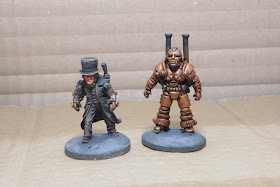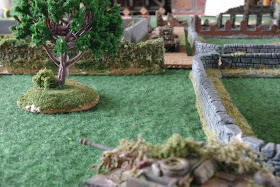As regular readers of this blog will know, I am a huge fan of the figures produced by Mark Copplestone. I've long admired his Back Of Beyond range, but I've never really wanted to buy large armies of the figures. However, it occurred to me that I could use his Bolsheviks for a band in games of In Her Majesty's Name and also in 7TV Pulp games. So, I need a setting for them, and where else should that be except in Borduria? So, here is a brief account of what happened to Borduria during the 19th century.
After the end of the Napoleonic Wars, during which both Syldavia and Borduria found themselves on the same side in various coalitions against the Emperor, things slowly began to change for these small nations. I shall come back at some future date to discuss Syldavia in the 19th century, so this will be all about Borduria.
The beginning of the 19th century saw the coronation of Autokrat Constantine III on New Year's Day 1802 He was the grandson of Constantine II who ruled the country from 1747 until his death in 1782, when he was succeeded by his son Demetrios I Cantacuzene, who was assassinated by an unknown hand in 1801.
Constantine III was very much under the influence of the Russian party in the Bordurian court, which had gained an ascendancy over the pro-Prussian faction in the last decade of the 18th century. The leader of the Russian party in the Samovar (the Bordurian assembly of boyars and de facto royal council),
Count Pyotr Strabomytes of Kardouk (the son of the Count Strabomytes against whom Sir William Huntley-Palmer fought a duel in Trieste in 1765) began to push Constantine towards a much more pro-Tsarist position.
Following the Congress of Vienna in 1814, Constantine III began to consolidate his position by purging the army of Prussian influences and beginning a period of Slavicisation of the organs of the state and the oppression of Roman Catholicism. Constantine promoted the most conservative elements in his court and during his reign, which ended in 1838, the country became more and more authoritarian. Following his death, his son Alexandros I continued his father's policies, with strict censorship of the press and a tightening of control over the country's education system, at one point closing all of the country's four universities for five years.
Alexandros I was assassinated by an Anarchist faction in 1851, without leaving an adult male heir. This led to a period of instability for a few years, with the Samovar appointing Count Michaelis Bazarov as co-regent with Alexandros' widow Elizavetna Romanova. Bazarov became unpopular with many boyars and landowners once his relationship with the Dowager Empress became clear and he was removed from office and imprisoned in Peshod Castle, where he died in mysterious circumstances. His removal allowed the young and ambitious Count Georgios Cantacuzene, from a junior branch of the ruling House to raise up an army and overthrow the Samovar in 1858. Refusing the title of Autokrator, he was acclaimed by a faction of liberal landowners as Voivode, adopting a traditional pre-Autocracy title for the ruler of the country. At first, the reign of Georgios seemed to herald a new dawn for Borduria, with a relaxation of the repressive laws of Constantine III and Alexandros, but liberalisation coincided with a renewal of war with Syldavia, leading to a succession of military defeats. Conservative elements in the Army and amongst rural boyars, supported by Tsarist agents in the country, launched a coup against Georgios, who was deposed and murdered in his palace in the capital, Szohôd in August 1865. Alexandros' son, Constantine was brought back from exile in Saint Petersburg, where his mother had taken him in 1859 and crowned Autokrator in October 1865. The return of repression was inevitable, but this time there was much opposition inside the country and civil disturbances, strikes and violence spread until it was necessary for Constantine IV to declare martial law in 1868.
There were many Bordurian exiles living across Eastern and Central Europe and these had organised political and revolutionary movements, some with links to German nationalists, other with Syldavian elements and still more with Marxist, Socialist and Anarchist groups. As martial law bit deep and unrest began to turn into conflict, the leader of the Proletarian Alliance, the largest exile Marxist grouping, Eugenios Laskarios, agreed a pact with the peasant Agrarian League and the (illegal) anarchist Union of Workers to form the Bordurian Proletarian Party. Fomenting dissent in the Army and carrying out a wave of assassinations and acts of terrorism, the BPP led the country in a general uprising in 1869. Many regiments of the army mutinied and killed their officers and a short but bloody Civil War ensued.
The city of Szohôd was besieged and other cities and towns began to rise up and expel their local governments. By the end of 1871, most of the country was in the hands of the BPP and Constantine and his family fled to Syldavia, from whence he made his way to Switzerland and then Russia. Laskarios proclaimed the end of the Autocracy and the beginning of the Bordurian Republic on the steps of the Royal Palace on March 1st 1872. He assumed the title of First Minister of the People's Provisional Government and began the process of purging the country of the old absolutist aristocracy. However, the process of nationalisation and the redistribution of land didn't run smoothly. There were disagreements and ideological differences in the Parliament and before long Laskarios and his Proletarian Alliance comrades realised that to preserve the revolution they would have to purge the government of its opponents and rule the country as a one-party state. In 1874, Laskarios shut down Parliament and his secret police and party militia launched another coup which brought about the final act of the Bordurian Revolution.
Since then, the Proletarian Alliance has ruled the country, with its head being known as the Chief Commissar. After the death of Eugenios Laskarios in 1881, the Leader has been Chief Commissar Michaelis Ivanovich. The Bordurian Secret Police, the Second Directorate (also called the Sekuritat), controls the press and oversees state security, while the Third Directorate is a secret intelligence organisation that operates in neighbouring countries, as well as those further away who harbour émigré Cantacuzenist and aristocratic communities and factions. These factions are all grouped together under the broad title of Autokratians, after the old title of the Bordurian Crown. Bourgeois and Liberal democratic groups are also targeted by the Third Directorate, popularly called the Informat.
Informat active units are not only intelligence gatherers and spies. They also carry out abductions and assassinations, as well as building up links with revolutionary groups and even criminal gangs in capitalist countries.














































